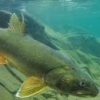
Plants and Lighting For My Riffle Tank
#1

Posted 04 August 2014 - 10:06 AM
1) The owner and my friend of my favorite LFS who is a planted tank pro says I should use coral sand as substrate, I was under the impression that it rose pH no? Either way would it be ok to use in my tank with a stock of 2 Rainbow Darters, 2 Greenside Darters, and 9 Emerald Shiners?
2) What would be the best type of bulb for native plants and how long should it be on per day?
3) Would it be ok to mix some of the looser gravel I already have in the tank in with sand since I think it'd look more natural or would that not be good for plants?
4) What are some good hardy (and I mean hardy) PA native plants that would go well in a tank this size and are somewhat easy to find? My sources would be my LFSs, my local creek, and my diving quarry but I'd prefer to get plants from my LFS.
Thanks!
#2
 Guest_gerald_*
Guest_gerald_*
Posted 04 August 2014 - 11:06 AM
2) Best Light bulb: I will leave that one to others, but I use 6000 to 7000 Kelvin fluorescent tubes, about 14 hrs a day. Native plants use the same wavelengths as tropical plants.
3) Mixing coarse gravel with sand: Yes, i do that too, with enough sand to fill in the gaps. However coarse gravel is probably NOT what killed your previous plants. Anubias, Java fern, and Anacharis (Egeria) can get what they need from the water and sand/gravel size shouldn't affect them.
4) PA native plants: Not too many that are good long-term aquarium plants. Elodea canadensis, Hornwort (Ceratophyllum), Najas guadalupenis, Vallisneria, Myriophyllum come to mind ... and duckweed.
#3

Posted 04 August 2014 - 11:34 AM
#4

Posted 04 August 2014 - 12:11 PM
You could also mix in some clay soil under your aragonite. Or some saf-t-sorb.
#5
 Guest_AMcCaleb_*
Guest_AMcCaleb_*
Posted 04 August 2014 - 12:16 PM
#6
 Guest_Stickbow_*
Guest_Stickbow_*
Posted 04 August 2014 - 03:59 PM
Timers are your friend too. A lot of the "lights out for an hour at midday" theories let you get maximum growth without too much algae.
#7
 Guest_steve_*
Guest_steve_*
Posted 04 August 2014 - 09:13 PM
The USDA shows Ludwigia palustris to be native to Pennsylvania as well as most of NA. It's a very attractive plant and I've had pretty good luck with it. It even looks good growing emergent too. I'm not sure how well it would do with a lot of water movement in the tank though. I've always kept it in very low flow areas of a tank or in a tank without much flow at all other than HOB filters. I've only collected it from ponds or wetland areas where there isn't any flow.Aren't there a few ludwigia species that can be found in Pennsylvania as well?
#8
 Guest_AMcCaleb_*
Guest_AMcCaleb_*
Posted 05 August 2014 - 06:59 AM
#9

Posted 06 August 2014 - 07:21 AM
#10
 Guest_swampfish_*
Guest_swampfish_*
Posted 07 August 2014 - 10:09 AM
Phil Nixon
#11
 Guest_gerald_*
Guest_gerald_*
Posted 07 August 2014 - 01:37 PM
#12
 Guest_steve_*
Guest_steve_*
Posted 08 August 2014 - 12:17 PM
#13

Posted 10 August 2014 - 03:03 PM
As far as plant selection goes I think I'll be doing hornwort and some type of Val to start and add more once I see I'm doing good with them.
1 user(s) are reading this topic
0 members, 1 guests, 0 anonymous users









